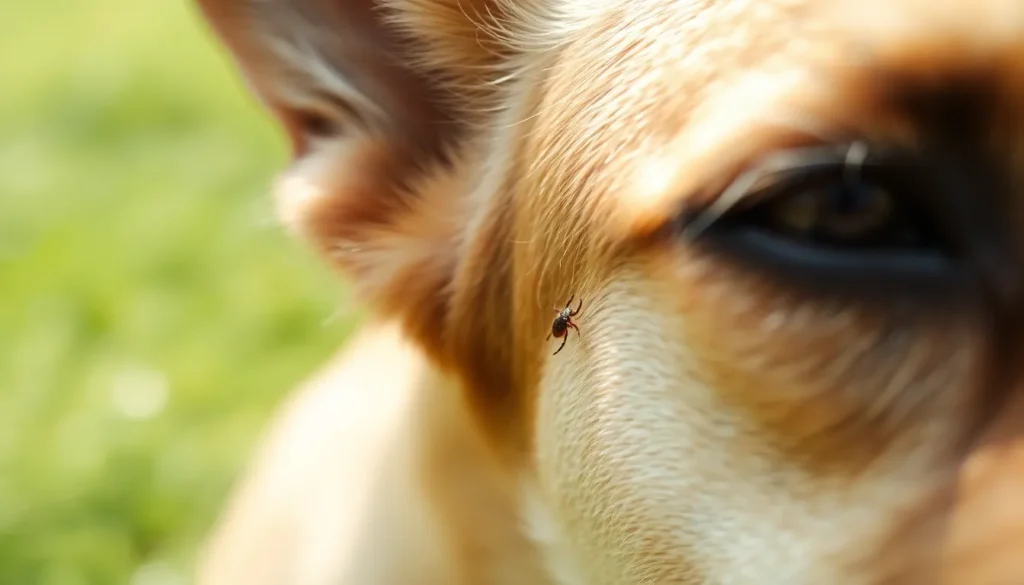Table of Contents
ToggleWhen it comes to our furry friends, a tick bite can turn a wagging tail into a worried whimper. Those tiny bloodsuckers are sneaky little ninjas that can cause big problems for dogs. But don’t worry—understanding what a tick bite looks like can be a game changer for pet owners.
Understanding Tick Bites on Dogs
Recognizing tick bites on dogs is essential for maintaining their health. Early detection allows for quicker treatment and helps prevent serious complications.
Importance of Timely Recognition
Timely recognition of tick bites significantly enhances veterinary outcomes. When owners spot a tick early, they can remove it before disease transmission occurs. Many tick-borne illnesses, such as Lyme disease and Rocky Mountain spotted fever, develop rapidly. Quick intervention helps prevent the progression of these diseases, ensuring a better chance of recovery. Staying vigilant, especially during warmer months, is crucial as ticks are more active, increasing the likelihood of bites.
Common Symptoms to Look For
Various symptoms indicate a potential tick bite on dogs. Swelling around the bite site often appears first, sometimes accompanied by redness or irritation. Dogs might exhibit scratching or excessive licking in the affected area, signaling discomfort. Other signs include lethargy and loss of appetite, which may indicate illness. Some dogs may run a fever or develop joint pain, both of which necessitate immediate veterinary attention. Awareness of these symptoms can lead to prompt action, improving a dog’s overall health.
Common Tick-Borne Diseases

Recognizing common tick-borne diseases is essential for safeguarding canine health. Various illnesses can affect dogs after a tick bite, leading to severe complications if left untreated.
Lyme Disease
Lyme disease ranks among the most prevalent tick-borne diseases in dogs. It stems from the bite of black-legged ticks that carry the Borrelia burgdorferi bacterium. Dogs may show symptoms such as fever, loss of appetite, and lameness due to joint pain. Diagnosis often involves blood tests, and treatment includes antibiotics. Timely intervention is crucial to prevent more severe health issues like kidney problems.
Ehrlichiosis
Ehrlichiosis is another serious disease caused by ticks, primarily the brown dog tick. This condition arises from the bacterium Ehrlichia canis, targeting white blood cells. Symptoms can manifest as lethargy, fever, swollen lymph nodes, and bleeding disorders. Early diagnosis improves recovery chances, typically through blood tests and treatment with antibiotics. Monitoring dogs for tick exposure significantly reduces the risk of contracting Ehrlichiosis.
Tick Removal Best Practices
Understanding the proper techniques for tick removal is crucial to protect a dog’s health. Following best practices minimizes the risk of infection and ensures effective dislodgment of the tick.
Tools for Safe Removal
Using specific tools makes tick removal safer and more effective. A pair of fine-tipped tweezers offers precision for grasping the tick close to the dog’s skin. Tick removal devices, available at pet stores or veterinary offices, also provide an alternative to tweezers. Gloves serve as a protective barrier against potential pathogens during the process. Alcohol wipes or antiseptic solutions help sanitize the area after removal. Having these tools on hand ensures quick action when a tick is spotted.
Steps to Remove a Tick
Completing tick removal involves a series of straightforward steps. First, calm the dog to reduce stress and movement. Next, grasp the tick as close to the skin surface as possible with tweezers or a removal tool. Pull upward with steady, even pressure without twisting. Securing the tick’s mouth parts is essential to prevent infection. After removal, clean the bite area thoroughly with antiseptic. Finally, observe the dog over the following days for any signs of illness or irritation, and consult a veterinarian if necessary.
Tick Bite on Dog Pictures
Tick bites can manifest in various areas on a dog’s body. Understanding where ticks commonly attach helps with early detection. Common locations include the ears, between the toes, under the collar, and near the tail. Pictures illustrating these areas offer guidance for pet owners, allowing them to inspect their dogs thoroughly.
Visual Guide to Tick Locations
Images of tick locations on dog bodies provide a clear visual reference. Ears often attract ticks due to their warmth and shelter. Between the toes serves as another common hiding spot, as these areas are often overlooked. Close examination of the neck, under collars, reveals a hotspot for ticks seeking a blood meal. The tail and groin area also require scrutiny due to easy accessibility for ticks. Familiarizing oneself with these visuals enhances the effectiveness of regular inspections.
Before and After Tick Removal Images
Before and after images of tick removals show significant changes in a dog’s skin condition. Initial appearances often reveal inflammation, swelling, or redness around the bite site. Post-removal images typically demonstrate a noticeable reduction in irritation. Capturing these stages can help owners understand the importance of prompt tick removal. Images highlight the necessity of monitoring the area for ongoing signs of infection or illness. Documenting this process aids other pet owners in recognizing potential complications related to tick bites.
Preventative Measures for Dog Owners
Preventing tick bites on dogs is vital for maintaining their health and wellbeing. Dog owners can take several measures to minimize the risk of ticks.
Tick Prevention Products
Tick prevention products include oral medications, topical treatments, and collars specifically designed for tick control. Oral medications such as afoxolaner and dinotefuran effectively kill ticks after they attach. Topical treatments contain ingredients like fipronil, which repel and eliminate ticks before they settle. Special collars infused with insecticides provide long-lasting protection, working continuously for up to eight months. Pet owners should consult their veterinarian to determine the best option based on their dog’s size, age, and overall health.
Regular Check-ups and Grooming
Regular check-ups are essential for early detection of ticks and potential health issues. Veterinarians can perform thorough examinations, helping ensure dogs remain tick-free. Grooming routines also play a critical role in tick prevention. Frequent brushing can help identify ticks hidden in fur, especially in long-haired breeds. Baths using tick-repelling shampoos can further deter ticks from latching on. Keeping dogs well-groomed and regularly visiting the vet ensures a comprehensive approach to tick prevention.
Tick bites pose a serious threat to dogs and can lead to significant health issues if not addressed promptly. Pet owners must remain vigilant and proactive in monitoring their dogs for signs of tick bites and potential illnesses. By understanding the risks associated with tick bites and implementing effective prevention strategies, they can help ensure their furry companions stay healthy and happy. Regular check-ups grooming and the appropriate use of tick prevention products can make a significant difference in safeguarding against these harmful parasites. Ultimately, staying informed and taking action will lead to better health outcomes for beloved pets.




